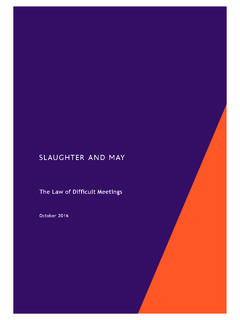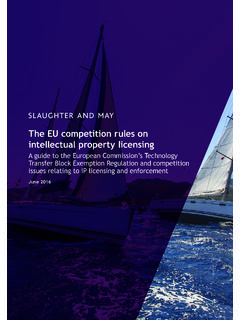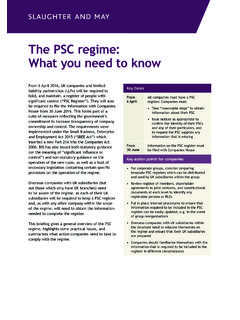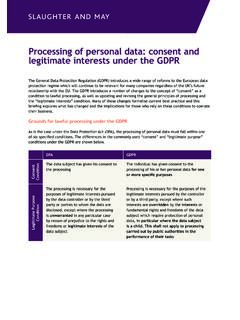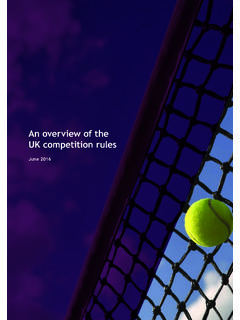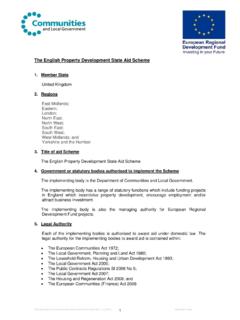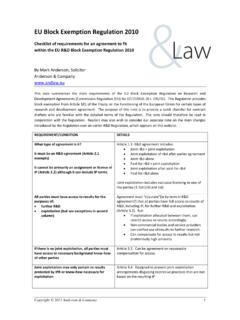Transcription of The EU competition rules on vertical agreements
1 The EU competition rules on vertical agreementsA guide to the assessment of vertical agreements (including the European Commission s block exemption regulations on vertical agreements and motor vehicle distribution)January 2018 / The EU competition rules on vertical agreementsContents1. Introduction 12. Focus on effects on competition 43. The safe harbours of the VABER and MVBER 64. Outside the safe harbours case-by-case analysis 8 Annex 1: What are vertical agreements and vertical restraints? 10 Annex 2: Relevant market definition issues 11 Annex 3: Analysing vertical agreements 13 Annex 4: Treatment of intellectual property rights 15 Annex 5: Hardcore restrictions 16 Annex 6: Other non-exempted vertical restraints under the VABER 21 Annex 7: Issues for Article 101 case-by-case analysis of vertical agreements 23 Annex 8: vertical Guidelines analysis of specific vertical restraints 271 / The EU competition rules on vertical agreements1.
2 This publication explains how the European competition rules are applied to vertical agreements , agreements for the sale or purchase of goods or services between parties operating (for the purpose of the particular agreement ) at different levels of the supply It considers the operation of the European Commission s vertical agreements block exemption regulation (VABER)1 and the Commission s accompanying vertical Guidelines which set out principles for the assessment of vertical agreements under Article 101 of the Treaty on the Functioning of the European It also considers the stricter rules applicable to the motor vehicle sector in the Commission s motor vehicle block exemption regulation (MVBER).3 Further detail on key stages of the analysis of vertical agreements is provided in the Annexes to this Businesses use various different types of vertical agreements to get their goods and services to market.
3 The concept of vertical agreement covers the purchase or supply of intermediate goods ( raw materials or goods subjected to further processing by the customer), finished goods ( for resale by a dealer active at the wholesaling or retailing level) or services. It also covers agency agreements . vertical agreements that look similar in form can have very different substantive effects on competition just as different types of agreements can have similar competitive effects depending on factors such as the conditions of competition in the markets concerned, and the parties strengths in those markets. The Article 101(1) prohibition applies where an agreement or concerted practice formal or informal, written or unwritten between two or more undertakings (businesses), which may affect trade between Member States, has the object or effect of preventing, restricting or distorting competition to an appreciable extent.
4 Even if an agreement falls within the scope of Article 101(1), it may be exempt from the prohibition if it has countervailing competitive benefits or efficiencies under Article 101(3). Some vertical agreements fall outside the scope of Article 101(1), such as agreements with final customers (not operating as undertakings), intra-group agreements and some agency agreements : see Annex vertical restraints (restrictions in vertical agreements ) tend to be considered less harmful than horizontal restraints (restrictions in agreements between companies operating at the same level(s) of production or distribution). This reflects the following: vertical agreements : In a vertical relationship the product of one party is the input of the other. This means that the exercise of market power by one party whether the upstream supplier or the downstream buyer may harm the commercial position of the other party.
5 Parties to a vertical agreement therefore usually have an incentive to prevent each other from imposing unreasonable restrictions. For most vertical agreements , serious competition concerns only arise if there 1 Commission Regulation (EU) 330/2010 (OJ 2010 L102/1, ). This block exemption replaced Commission Regulation (EC) 2790/1999 and came into force on 1 June 2010 expires on 31 May 2022. It was incorporated into the EEA competition rules by EEA Joint Committee Decision No. 077/2010 (amending Annex XIV to the EEA agreement ).2 Guidelines on vertical Restraints (OJ 2010 C131/01, ). The EFTA Surveillance Authority has adopted equivalent guidelines. The Commission has also published a more concise brochure on The competition rules for supply and distribution Commission Regulation (EU) 461/2010 (OJ 2010 L129/52, ) MVBER applies to vertical agreements relating to the motor vehicle aftermarket, which includes the purchase, sale or resale of spare parts or provision of repair and maintenance services.
6 The general VABER applies to the purchase, sale or resale of motor The EU competition rules on vertical agreements / is insufficient inter-brand competition in the markets affected by the agreement , if the supplier (and/or buyer) has a high degree of market power. Horizontal agreements : In a horizontal relationship in particular between actual or realistic potential competitors the exercise of market power by one party (to the potential detriment of third parties) may actually also benefit the other party. The Commission is therefore generally more wary of cooperation between parties active at the same level in the supply chain, particularly where the agreement has the object of fixing prices, limiting production or sharing markets or Accordingly, many vertical agreements either fall outside the Article 101(1) prohibition altogether or satisfy the exemption criteria of Article 101(3).
7 5 Where this is not the case, restrictive provisions in the agreement will be void by virtue of Article 101(2) (and possibly under Article 102 in the case of dominant companies). In serious cases, the European Commission s Directorate- general for competition and/or the Member States national competition authorities (NCAs) may investigate, and declare the restrictive provisions, and possibly the whole agreement , void and may impose fines. The NCAs play a significant role in the enforcement of Articles 101 and 102 in accordance with Council Regulation 1 The Commission and NCAs cooperate with each other within the framework of the European competition Network (ECN) to coordinate investigations or allocate cases. Third parties may also bring claims for damages in courts in Member The VABER and MVBER provide safe harbours for agreements if certain formal conditions are satisfied, regardless of whether they may have positive or negative effects on competition in the relevant market.
8 The VABER and vertical Guidelines are available for any vertical agreement , including industrial supply contracts, selective distribution systems, agency arrangements or non-exclusive purchasing and distribution arrangements. Companies are not expected to squeeze their vertical arrangements into the straitjackets of agreements covered by previous block exemptions (on exclusive distribution, exclusive purchasing or franchising, for example). That said, the MVBER impose stricter requirements on the motor vehicle In the field of horizontal cooperation , block exemptions are available for R&D agreements and specialisation agreements . The Commission has also adopted guidelines on the applicability of Art. 101 to horizontal cooperation. These block exemptions and Horizontal Guidelines are considered in more detail in the Slaughter and May publication on The EU competition rules on horizontal agreements .
9 The Horizontal Guidelines focus in particular on agreements on R&D, production agreements ( joint production, specialisation and outsourcing agreements , subcontracting between competitors), purchasing agreements , commercialisation agreements , agreements on standards. They do not cover other forms of agreements between competitors such as minority shareholdings and strategic alliances; nor do they cover joint ventures notifiable under the EU Merger Regulation (see the Slaughter and May publication on The EU Merger Regulation).5 Agency agreements are not caught by Art. 101(1) if the principal bears the commercial and financial risks related to the selling and purchasing of contract goods and services and obligations imposed on the agent in relation to the contracts concluded and or negotiated on behalf of the principal (see also Annex 1).
10 However, agency agreements containing single branding provisions and post-term non-compete provisions may infringe Art. 101(1) if they lead to or contribute to a (cumulative) foreclosure effect. Agency agreements may also fall within the scope of Art. 101(1) where a number of principals coordinate their activities by using the same This Implementing Regulation fundamentally changed the way in which Arts. 101 and 102 are enforced (Council Regulation (EC) 1/2003; OJ 2003 L1/1, ). Its objectives were: to facilitate more rigorous enforcement against blatant infringements such as cartels (inter alia by abolishing the system of notifying agreements to the Commission to obtain individual exemptions under Art. 101(3)); to allow decentralisation of the application of the rules (in particular the Art.)
